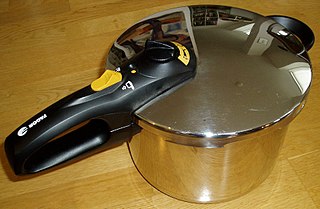
Cooking, cookery, or culinary arts is the art, science and craft of using heat to make food more palatable, digestible, nutritious, or safe. Cooking techniques and ingredients vary widely, from grilling food over an open fire to using electric stoves, to baking in various types of ovens, reflecting local conditions.

French fries, chips, finger chips, french-fried potatoes, or simply fries, are batonnet or allumette-cut deep-fried potatoes of disputed origin from Belgium or France. They are prepared by cutting potatoes into even strips, drying them, and frying them, usually in a deep fryer. Pre-cut, blanched, and frozen russet potatoes are widely used, and sometimes baked in a regular or convection oven; air fryers are small convection ovens marketed for frying potatoes.

Pressure cooking is the process of cooking food under high pressure steam and water or a water-based cooking liquid, in a sealed vessel known as a pressure cooker. High pressure limits boiling and creates higher cooking temperatures which cook food far more quickly.

Louisiana Creole cuisine is a style of cooking originating in Louisiana, United States, which blends West African, French, Spanish, and Native American influences, as well as influences from the general cuisine of the Southern United States.

Outdoor cooking is the preparation of food in the outdoors. A significant body of techniques and specialized equipment exists for it, traditionally associated with nomadic cultures such as the Berbers of North Africa, the Arab Bedouins, the Plains Indians, pioneers in North America, and indigenous tribes in South America. These methods have been refined in modern times for use during recreational outdoors pursuits, by campers and backpackers.

A fried egg is a cooked dish made from one or more eggs which are removed from their shells and placed into a frying pan and fried. They are traditionally eaten for breakfast in many countries but may also be served at other times of the day.

Rösti or rööschti is a Swiss dish consisting mainly of potatoes, sautéed or shallow-fried in a pan. It was originally a breakfast dish, commonly eaten by farmers in the canton of Bern, but is now eaten all over Switzerland and around the world. The French name röstis bernois directly refers to the dish's origins.

Biryani is a mixed rice dish originating among the Muslims of South Asia. It is made with spices, vegetables, rice, and usually some type of meat. In some cases without any meat, and sometimes with eggs and potatoes.

Boxty is a traditional Irish potato pancake. The dish is mostly associated with the north midlands, north Connacht and southern Ulster, in particular the counties of Leitrim, Mayo, Sligo, Donegal, Fermanagh, Longford, and Cavan. There are many recipes but all contain finely grated, raw potatoes and all are served fried.

Confit is any type of food that is cooked slowly over a long period as a method of preservation.

The following outline is provided as an overview of and topical guide to food preparation:

Heavy-duty cookware made of cast iron is valued for its heat retention, durability, ability to maintain high temperatures for longer time duration, and non-stick cooking when properly seasoned. Seasoning is also used to protect bare cast iron from rust. Types of cast iron cookware include frying pans, dutch ovens, griddles, waffle irons, flattop grills, panini presses, crepe makers, deep fryers, tetsubin, woks, potjies, and karahi.

Neapolitan cuisine has ancient historical roots that date back to the Greco-Roman period, which was enriched over the centuries by the influence of the different cultures that controlled Naples and its kingdoms, such as that of Aragon and France.

Fried chicken, also known as Southern fried chicken, is a dish consisting of chicken pieces that have been coated with seasoned flour or batter and pan-fried, deep fried, pressure fried, or air fried. The breading adds a crisp coating or crust to the exterior of the chicken while retaining juices in the meat. Broiler chickens are most commonly used.

Fried potatoes are a dish or a component of other dishes essentially consisting of potatoes which have been fried or deep-fried in hot cooking oil often with the addition of salt and other seasonings. They are often served as a side dish.

Shallow frying is a hot oil-based cooking technique. It is typically used to prepare portion-sized cuts of meat, fish, potatoes and patties such as fritters. Shallow frying can also be used to cook vegetables.

Frying is the cooking of food in oil or another fat. Similar to sautéing, pan-fried foods are generally turned over once or twice during cooking to make sure that the food is well-made, using tongs or a spatula, while sautéed foods are cooked by "tossing in the pan". A large variety of foods may be fried.

Chinese cooking techniques are a set of methods and techniques traditionally used in Chinese cuisine. The cooking techniques can either be grouped into ones that use a single cooking method or a combination of wet and dry cooking methods.

Triple-cooked chips are a type of chips developed by the English chef Heston Blumenthal. Blumenthal began work on the recipe in 1993, and eventually developed the three-stage cooking process. The chips are first simmered, then cooled and drained using a sous-vide technique or by freezing; deep fried at 130 °C (266 °F) and cooled again; and finally deep-fried again at 180 °C (356 °F). The result is what Blumenthal calls "chips with a glass-like crust and a soft, fluffy centre".


















